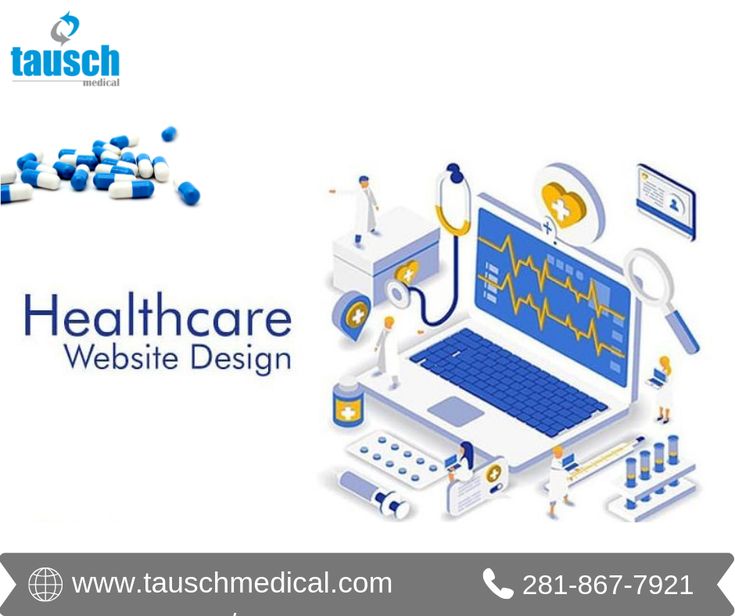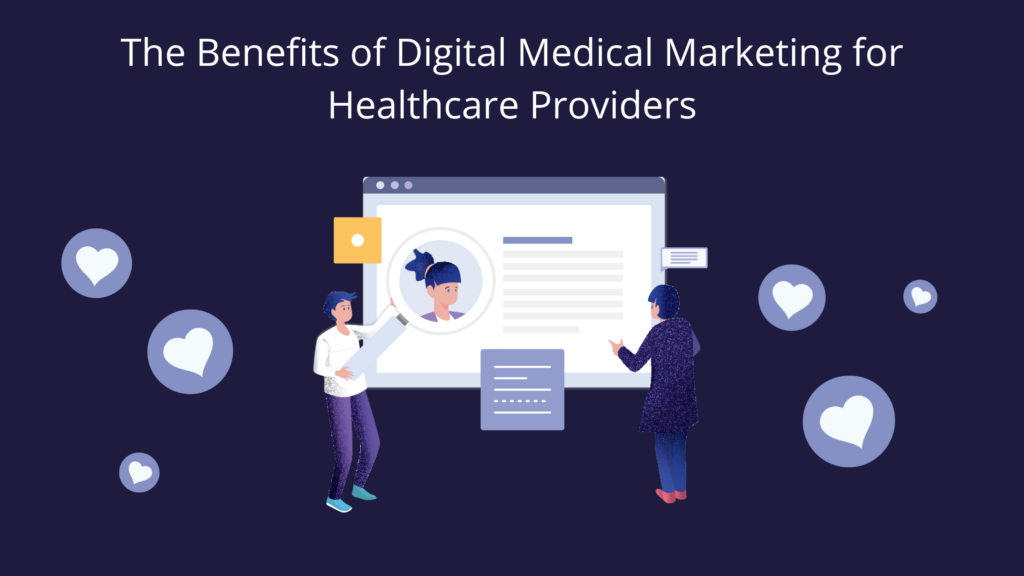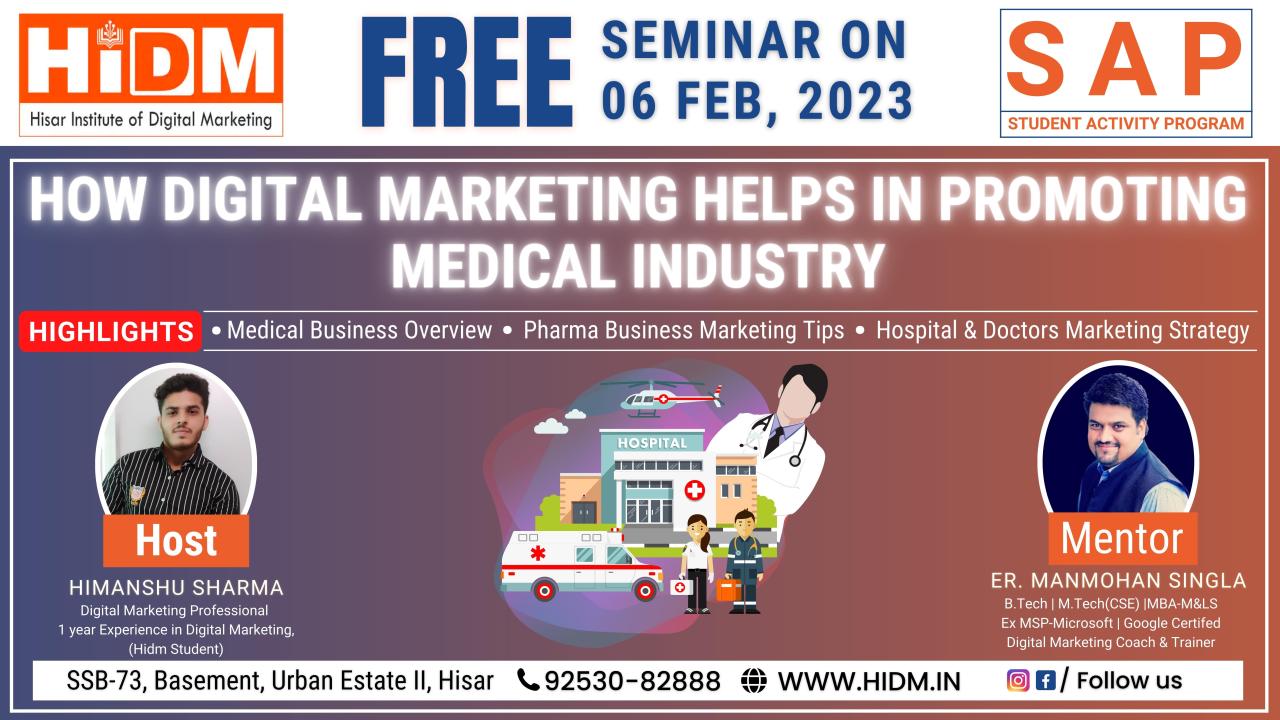Unleash the power of digital innovation in the medical field! Medical digital marketing is no longer a fringe concept; it’s a crucial tool for modern healthcare providers. This comprehensive guide delves into the strategies, tactics, and ethical considerations essential for navigating the digital landscape and connecting with patients and professionals alike.
From crafting compelling content to mastering the nuances of , this exploration unpacks the key components of a successful medical digital marketing strategy. We’ll also examine how to effectively leverage digital channels and platforms to reach your target audience, and how to measure the impact of your efforts. Ethical considerations and compliance are integral parts of this conversation.
Defining Medical Digital Marketing
Medical digital marketing is a multifaceted approach to promoting healthcare services and products online. It leverages various digital channels to reach potential patients, build brand awareness, and drive engagement. This strategy goes beyond simply creating a website; it involves a comprehensive online presence designed to attract, inform, and convert prospective patients into loyal clients.
Defining Medical Digital Marketing
Medical digital marketing encompasses all online activities used by healthcare providers and organizations to connect with potential patients and clients. It’s not merely a digital extension of traditional marketing but a distinct discipline with its own set of best practices and ethical considerations. Key differences lie in the need for stringent data privacy compliance (like HIPAA) and the importance of patient trust and transparency.
Key Components of a Comprehensive Medical Digital Marketing Strategy
A robust medical digital marketing strategy requires a holistic approach, encompassing several crucial elements. These include:
- Search Engine Optimization (): Optimizing online content to rank higher in search engine results pages (SERPs). This involves research, on-page optimization, and off-page strategies to increase visibility for relevant searches.
- Search Engine Marketing (SEM): Using paid advertising to enhance visibility on search engines. This often includes Google Ads campaigns targeted at specific demographics and search queries.
- Social Media Marketing: Utilizing social media platforms to connect with potential patients, share valuable information, and build brand awareness. This requires strategic content creation, community engagement, and a strong brand voice.
- Email Marketing: Building email lists and sending targeted communications to patients and prospects. This can include newsletters, promotional offers, and appointment reminders.
- Website Development and Design: Creating user-friendly, informative, and visually appealing websites. Mobile responsiveness and clear calls to action are critical for patient engagement.
- Content Marketing: Creating and sharing valuable content, such as blog posts, articles, videos, and infographics, to educate and inform potential patients.
- Reputation Management: Monitoring and responding to online reviews and feedback. This involves actively managing patient perception and ensuring a positive online presence.
Differences Between Medical Digital Marketing and General Digital Marketing
Medical digital marketing differs significantly from general digital marketing due to the highly regulated nature of the healthcare industry. Ethical considerations and legal compliance are paramount.
- Compliance with Regulations: Medical digital marketing must adhere to stringent regulations like HIPAA (Health Insurance Portability and Accountability Act) to protect patient data. General digital marketing doesn’t have these same restrictions.
- Emphasis on Trust and Transparency: Building patient trust and ensuring transparency is crucial in medical digital marketing. This involves clearly outlining the services offered and the provider’s qualifications.
- Focus on Patient Education: Providing accurate and accessible information to patients is central to medical digital marketing. This goes beyond basic product promotion and emphasizes patient empowerment.
- Specific Target Audience: Medical marketing targets a specific demographic with particular needs and health concerns, unlike general marketing’s broader approach.
Evolving Role of Medical Digital Marketing in Healthcare
Medical digital marketing is becoming increasingly crucial in the modern healthcare landscape. It facilitates patient access to information, streamlines appointment scheduling, and improves overall patient experience.
- Telemedicine Growth: Digital platforms are vital for facilitating telemedicine consultations, expanding access to care, and promoting remote patient monitoring.
- Patient Engagement: Digital marketing fosters two-way communication, allowing patients to actively engage with their healthcare providers.
- Improved Accessibility: Digital tools make healthcare services more accessible to individuals in remote or underserved areas.
Core Differences Between Traditional and Digital Medical Marketing
The following table highlights the key distinctions between traditional and digital medical marketing approaches:
| Feature | Traditional Medical Marketing | Digital Medical Marketing | Key Differences |
|---|---|---|---|
| Reach | Limited geographic area; targeted to specific demographics via print and mail | Global reach; highly targeted via various online channels | Digital marketing offers significantly broader reach. |
| Cost | Higher upfront costs for print materials, advertising, and events | Potentially lower long-term costs; pay-per-click advertising allows for control over budget. | Digital marketing offers flexibility and cost-effectiveness. |
| Measurability | Difficult to track effectiveness of individual campaigns; relies on broad metrics | Detailed metrics and analytics on campaign performance; track key metrics like website traffic and conversions | Digital marketing provides measurable results and actionable insights. |
| Engagement | Passive engagement; one-way communication | Active engagement; two-way communication through online channels | Digital marketing enables interactive communication and feedback. |
Target Audience & Segmentation
Medical digital marketing strategies must carefully consider the diverse needs and expectations of various stakeholders. Understanding the specific characteristics and behaviors of these groups allows for more effective campaigns that resonate with each audience segment. This targeted approach maximizes campaign impact and ensures resources are allocated strategically.
Identifying Target Audiences
Medical digital marketing encompasses a wide range of stakeholders, each with unique motivations and goals. These audiences include patients seeking information and treatment, medical professionals seeking knowledge and resources, hospitals and clinics striving to improve services and attract new patients, and pharmaceutical companies aiming to connect with healthcare providers. Understanding the distinct needs of each group is crucial for crafting effective strategies.
Segmenting Target Audiences
Effective segmentation is paramount in medical digital marketing. By categorizing audiences based on shared characteristics, marketers can tailor their messages and channels to resonate with each group. This approach leads to higher engagement and conversion rates. Segmentation allows for more focused and impactful campaigns.
Demographic and Psychographic Segmentation for Medical Professionals
Medical professionals, such as doctors, nurses, and researchers, can be segmented based on factors like specialization, years of experience, practice location, and professional certifications. Psychographic segmentation considers factors like their professional values, attitudes toward new technologies, and preferred learning styles. This approach allows marketers to tailor content to specific needs and interests, making it more likely to capture their attention and drive engagement. For example, a segmentation strategy could target cardiologists in large metropolitan areas who are interested in utilizing new AI-based diagnostic tools.
Importance of Understanding Patient Journeys
Understanding the patient journey is vital in medical digital marketing. This involves mapping out the steps a patient takes from initial awareness to treatment and follow-up care. By understanding these touchpoints, marketers can strategically place content to guide patients along their path. This knowledge enables the creation of targeted campaigns that address specific needs and concerns at each stage of the patient journey.
Specific Needs and Preferences of Each Target Audience Segment
| Target Audience Segment | Specific Needs | Preferences |
|---|---|---|
| Patients | Reliable information about conditions, treatment options, and healthcare providers. Accessibility to appointments and services. | User-friendly websites, clear and concise information, interactive tools, secure online appointment scheduling, and transparent pricing. |
| Medical Professionals | Access to continuing medical education (CME) resources, latest research, and professional networking opportunities. | Credible sources of information, peer-reviewed articles, opportunities for collaboration and networking, and high-quality presentations. |
| Hospitals & Clinics | Increased patient engagement, improved online visibility, and attracting new patients. | User-friendly websites, online appointment scheduling, patient portals, and effective marketing campaigns that resonate with their target demographics. |
| Pharmaceutical Companies | Reaching healthcare providers, building relationships with key opinion leaders, and promoting new products. | Targeted content relevant to their specific areas of expertise, scientific data supporting their claims, and opportunities for collaboration and discussion. |
Content Strategy & Creation
Effective medical digital marketing hinges on a robust content strategy. Attracting and engaging potential patients requires crafting compelling and informative content tailored to specific medical specialties and target audiences. This involves a deep understanding of their needs and preferences, which are addressed through various formats and carefully optimized for search engines.
Creating a content strategy that resonates with the target audience is crucial for achieving optimal results. This involves identifying the most suitable content types and formats, crafting engaging narratives, and ensuring optimization to maximize visibility and reach.
Content Types for Medical Digital Marketing
Content variety is key in medical digital marketing. Different content formats cater to different learning styles and preferences. Blog posts, articles, videos, infographics, and case studies all play a vital role in educating and engaging potential patients. Each format can effectively communicate complex medical information in a clear and accessible way.
- Blog posts and articles: These offer a platform to delve into specific medical topics in detail. They can address common health concerns, explain medical procedures, or highlight success stories. They are excellent for providing in-depth information and establishing thought leadership within a medical specialty.
- Videos: Videos are exceptionally effective for visual learners. Animated explainer videos, interviews with medical professionals, or patient testimonials can convey complex information in a more engaging and accessible manner. Short, easily digestible videos, such as tips on maintaining good health, can be highly effective.
- Infographics: These visually represent complex medical data or procedures, making them easily understandable. Infographics on health risks, treatment options, or surgical procedures can quickly communicate vital information to potential patients.
- Case studies: These showcase successful outcomes and demonstrate the value of specific treatments or procedures. Presenting real-life examples can be highly persuasive and build trust among potential patients.
Creating Compelling and Informative Content
Compelling medical content should be both informative and engaging. Content must accurately reflect medical knowledge and adhere to ethical guidelines for medical information dissemination. This includes verifying information sources and consulting with medical experts.
- Accuracy and Clarity: Medical content must be meticulously accurate. It should use clear, concise language to avoid ambiguity. Employing medical terminology in an accessible way, avoiding jargon, and explaining technical terms is crucial.
- Engaging Storytelling: Content should resonate with the target audience by weaving a compelling narrative. This could involve patient stories, expert interviews, or the impact of treatments on people’s lives. Stories make complex medical information more relatable and memorable.
- Call to Action (CTA): Every piece of content should have a clear call to action. This could be scheduling a consultation, requesting more information, or visiting a specific webpage.
Optimization in Medical Digital Marketing
Search engine optimization () is critical for increasing online visibility and driving traffic to medical websites. This involves optimizing content for relevant s and improving website structure.
- Research: Understanding the s potential patients use when searching for medical information is essential. Conduct thorough research to identify the most relevant terms for each specialty.
- On-Page Optimization: Optimizing website content and meta descriptions with relevant s can significantly improve search engine rankings. This involves careful consideration of meta tags, page titles, and header tags.
- Link Building: Building high-quality backlinks from reputable websites can boost search engine rankings. This involves securing mentions on other health-related websites and publications.
Examples of Engaging and Informative Content
Different medical specialties require tailored content. For example, a cardiologist might create content explaining heart conditions and treatment options, while a dermatologist could offer tips on skincare and preventing skin diseases.
- Cardiology: A blog post explaining the different types of heart conditions, with illustrative diagrams and patient testimonials. Videos showcasing cardiac procedures and their benefits, and infographics presenting risk factors and preventive measures. Case studies showcasing successful heart surgery outcomes.
- Dermatology: Articles on common skin conditions and their treatments, along with images of different skin conditions and their corresponding treatments. Videos featuring dermatologists explaining skin cancer prevention strategies. Infographics detailing the importance of sun protection and skin cancer awareness.
Content Format and Target Audience Table
| Content Format | Ideal Use for General Audience | Ideal Use for Specific Patient Groups (e.g., pregnant women, seniors) | Ideal Use for Medical Professionals |
|---|---|---|---|
| Blog Posts | Explaining common health concerns, providing health tips | Addressing pregnancy-related health concerns, providing specific advice for senior health | Sharing research findings, discussing medical advancements |
| Videos | Explaining medical procedures, showcasing doctor profiles | Providing prenatal care tips, showing exercises for seniors | Presenting medical lectures, demonstrating surgical techniques |
| Infographics | Visualizing health statistics, presenting disease information | Summarizing pregnancy stages, depicting aging process | Illustrating research data, displaying treatment algorithms |
| Case Studies | Demonstrating success stories, building trust | Highlighting specific success stories related to patient groups | Presenting successful treatment outcomes, analyzing treatment effectiveness |
Digital Channels & Platforms

Reaching the right patients in the digital age requires a multi-faceted approach. Leveraging diverse digital channels and platforms is crucial for effective medical digital marketing, allowing healthcare providers to connect with potential patients, build trust, and ultimately drive engagement and conversions. This section delves into the specifics of various digital channels, their effectiveness, and how to strategically deploy them for optimal results.
Effective medical digital marketing involves a deep understanding of how different channels resonate with diverse patient demographics. This includes analyzing which platforms are most frequently used by the target audience, considering factors like age, location, and preferred communication styles. By tailoring strategies to these nuances, healthcare providers can maximize their impact and achieve better outcomes.
Various Digital Channels
Understanding the diverse range of digital channels available is fundamental to a comprehensive medical marketing strategy. These channels include social media, search engines, email marketing, and websites, each offering unique advantages and disadvantages.
- Social Media: Platforms like Facebook, Instagram, and Twitter offer opportunities to engage directly with potential patients, share informative content, and build a community. Targeted advertising capabilities allow for precise audience segmentation, increasing the effectiveness of campaign reach. However, maintaining consistent posting schedules and managing potential negative feedback requires dedicated resources. Examples include health awareness campaigns and patient testimonials.
- Search Engines (): Search engine optimization () is vital for driving organic traffic to healthcare websites. Optimizing content for relevant s ensures that the website appears prominently in search results, increasing visibility and attracting potential patients actively searching for specific medical services.
- Email Marketing: Email marketing allows for direct communication with patients. Targeted email campaigns can provide updates on new services, appointment reminders, and health-related information, strengthening patient relationships and building trust. However, ensuring email lists are managed appropriately and adhering to privacy regulations is critical.
- Websites: A well-designed website is the cornerstone of any medical digital marketing strategy. It serves as the central hub for all online interactions, providing information about services, contact details, and appointment scheduling options. A user-friendly design, clear navigation, and high-quality content are essential for attracting and retaining patients.
Strategies for Healthcare Websites
Effective for healthcare websites requires a specific approach to address the sensitivity and complexity of the information shared. Optimizing website content for relevant s, including location-specific terms, is critical for visibility in search engine results.
- Research: Identifying relevant s specific to medical services and geographical locations is essential for attracting targeted traffic. Analyzing search trends and competitor strategies is crucial to identify high-volume, low-competition s.
- Content Optimization: High-quality, informative content is paramount. This includes detailed descriptions of medical services, informative blog posts, and patient testimonials. Clear, concise, and accurate information builds trust and credibility.
- Technical : Ensuring the website is technically sound, including site speed, mobile-friendliness, and proper indexing, is crucial for optimal search engine performance. This includes appropriate meta descriptions, title tags, and structured data.
Comparison of Digital Platforms
Different digital platforms offer unique advantages and disadvantages in medical marketing. Careful consideration of these factors is essential for tailoring a strategy to specific goals and target audiences.
| Digital Platform | Advantages | Disadvantages |
|---|---|---|
| Social Media | Direct engagement, targeted advertising, community building | Potential for negative feedback, requires consistent effort |
| Search Engines | Organic traffic, high visibility, targeted reach | Requires ongoing optimization, can be time-consuming |
| Email Marketing | Direct communication, targeted campaigns, appointment reminders | Requires a compliant mailing list, potential for spam complaints |
| Websites | Central hub for information, appointment scheduling, brand representation | Requires ongoing maintenance, needs optimization |
Effectiveness of Digital Channels by Target Audience
The effectiveness of different digital channels can vary significantly depending on the target audience segment. Understanding these variations allows for targeted campaigns that resonate most effectively with each group.
| Target Audience Segment | Social Media | Search Engines | Email Marketing | Websites |
|---|---|---|---|---|
| Millennials | High effectiveness | Moderate effectiveness | Moderate effectiveness | High effectiveness |
| Gen Z | Very high effectiveness | High effectiveness | Moderate effectiveness | Moderate effectiveness |
| Baby Boomers | Moderate effectiveness | Moderate effectiveness | High effectiveness | High effectiveness |
Measurement & Analytics

Tracking and analyzing the performance of medical digital marketing campaigns is crucial for optimizing strategies and maximizing ROI. Accurate measurement allows healthcare organizations to understand what’s working, identify areas for improvement, and ultimately, achieve better patient outcomes. This data-driven approach ensures resources are allocated effectively and campaigns remain aligned with overall objectives.
Key Metrics for Evaluating Success
Understanding the key performance indicators (KPIs) is essential for assessing the effectiveness of medical digital marketing campaigns. Different metrics will be relevant depending on the specific goals of the campaign, such as driving website traffic, generating leads, or increasing brand awareness. The selection and tracking of appropriate metrics provide valuable insights into the success of the campaign.
- Website traffic: Website traffic measures the number of visitors to a website. This metric is important for understanding the reach of digital marketing efforts and evaluating the effectiveness of different channels in driving traffic to the site. High website traffic can indicate increased brand visibility and potential for lead generation. Tracking changes in traffic over time reveals trends and the impact of various marketing activities.
- Conversion rate: The conversion rate measures the percentage of website visitors who complete a desired action, such as filling out a contact form, scheduling a consultation, or downloading a resource. This metric directly reflects the effectiveness of the campaign in achieving its objectives. High conversion rates indicate that the campaign is successfully engaging potential patients and driving desired actions.
- Lead generation: Lead generation metrics focus on the number of qualified leads generated through digital marketing channels. This involves tracking the number of individuals who express interest in a product or service, often through forms or other interaction mechanisms. Analyzing the quality of leads, such as demographics and interest levels, is crucial to understanding the effectiveness of the campaign in generating suitable prospects.
- Engagement metrics: Engagement metrics encompass various actions users take on a website or social media platforms, such as time spent on a page, click-through rates, and social media shares. Higher engagement rates often correlate with increased brand awareness and interest in the medical services offered.
- Return on investment (ROI): ROI measures the profitability of a marketing campaign by comparing the revenue generated to the costs incurred. This metric is crucial for demonstrating the financial value of digital marketing initiatives and justifying future investments.
Tracking and Analyzing Data for Optimization
Effective data tracking and analysis are essential for optimizing campaign performance. This involves using tools and techniques to monitor and interpret the data collected. By analyzing patterns and trends, marketers can make informed decisions about campaign adjustments and improvements.
- Data visualization tools: Data visualization tools are crucial for transforming raw data into easily understandable representations, such as charts and graphs. These visual aids allow marketers to quickly identify trends, patterns, and anomalies in the data, enabling them to make data-driven decisions for campaign adjustments.
- A/B testing: A/B testing is a method of comparing two versions of a marketing asset, such as a landing page or advertisement, to determine which performs better. This approach is used to optimize campaigns and enhance user experience. By identifying elements that resonate best with the target audience, marketers can continuously refine their campaigns.
- Regular reporting and analysis: Regular reporting and analysis are essential for monitoring campaign performance and identifying areas for improvement. This involves regularly reviewing key metrics and analyzing the data to understand the effectiveness of different strategies. The data should be reviewed regularly and analyzed for patterns, trends, and areas needing adjustment.
Best Practices for Data Interpretation
Interpreting data effectively requires considering the context of the healthcare industry and the specific goals of the campaign. Data interpretation should not be done in isolation, but in conjunction with other factors.
- Contextual understanding: Understanding the context of the healthcare industry is essential for accurate data interpretation. Factors such as patient demographics, healthcare regulations, and market trends should be considered when evaluating campaign performance.
- Comparison to benchmarks: Comparing campaign performance against industry benchmarks provides valuable insights into the effectiveness of the strategies employed. This helps in identifying areas where the campaign excels and where improvements are needed.
- Correlation vs. causation: It’s crucial to differentiate between correlation and causation when analyzing data. Simply because two variables are related doesn’t mean one causes the other. Carefully analyze the relationship between different factors to ensure accurate interpretations.
Importance of Data-Informed Strategies
Data-informed strategies are essential for adapting to evolving patient needs and market trends. By continuously monitoring and analyzing data, healthcare organizations can refine their strategies and optimize their campaigns for maximum effectiveness.
| KPI | Explanation |
|---|---|
| Website Traffic | Number of visitors to the website |
| Conversion Rate | Percentage of visitors who complete a desired action |
| Lead Generation | Number of qualified leads generated |
| Engagement Metrics | User interaction on the website or social media |
| ROI | Return on investment for the campaign |
Ethical Considerations & Compliance

Medical digital marketing, while offering significant opportunities, necessitates a strong ethical framework and adherence to stringent regulations. Navigating the digital landscape responsibly and ethically is crucial to maintain patient trust and uphold professional standards. This involves understanding the unique challenges presented by the digital space and implementing robust strategies to ensure compliance with relevant laws and guidelines.
The digital realm blurs traditional boundaries, making it vital to understand the implications of online interactions on patient care and privacy. This section delves into the specific ethical considerations and compliance measures essential for ethical medical digital marketing practices.
Ethical Considerations in Medical Digital Marketing
Medical digital marketing strategies must prioritize patient well-being and avoid misleading or exploitative practices. Ethical considerations encompass various aspects, from maintaining patient confidentiality to avoiding unsubstantiated claims about treatment efficacy. Misrepresentation of medical treatments or services, for example, can have severe consequences for patients and erode public trust in healthcare providers.
HIPAA Compliance in Digital Marketing Strategies
Maintaining patient confidentiality is paramount in medical digital marketing. HIPAA (Health Insurance Portability and Accountability Act) regulations dictate how protected health information (PHI) should be handled. Digital marketing strategies must incorporate robust measures to safeguard patient data, ensuring compliance with HIPAA standards. This includes secure storage and transmission of data, appropriate access controls, and training for staff handling sensitive information. Failure to adhere to HIPAA regulations can lead to significant penalties and reputational damage.
Regulations and Guidelines for Medical Advertising
Federal and state regulations govern medical advertising, requiring accuracy, clarity, and transparency. Advertisers must adhere to guidelines regarding claims made about treatments, procedures, or devices. For example, claims about the effectiveness of a treatment must be supported by credible scientific evidence. Misleading or unsubstantiated claims can result in legal action and damage to the reputation of the healthcare provider. The Federal Trade Commission (FTC) and state medical boards have established guidelines that detail specific requirements for medical advertising.
Examples of Ethical Dilemmas in Medical Digital Marketing and Their Solutions
Several ethical dilemmas can arise in medical digital marketing. One example involves the use of testimonials. While testimonials can be beneficial, using fabricated or misleading testimonials is unethical. The solution involves verifying the authenticity of testimonials and ensuring they accurately reflect the experience of the patient. Another ethical dilemma involves targeting specific patient groups. For example, targeting vulnerable populations with potentially misleading or aggressive advertising is ethically problematic. This ethical concern should be addressed by employing targeted messaging that considers the specific needs and circumstances of each patient group. Using diverse and culturally sensitive marketing approaches is crucial.
Table Summarizing Key Ethical Considerations and Relevant Regulations
| Ethical Consideration | Relevant Regulations |
|---|---|
| Patient Confidentiality (HIPAA) | Health Insurance Portability and Accountability Act (HIPAA) |
| Accuracy and Transparency in Claims | Federal Trade Commission (FTC) guidelines, State Medical Board regulations |
| Avoidance of Misleading or Exploitative Practices | FTC guidelines, State Medical Board regulations |
| Responsible Targeting of Patient Groups | Ethical guidelines for marketing to vulnerable populations |
| Authenticity of Testimonials | Ethical guidelines for testimonials and endorsements |
Case Studies & Best Practices

Medical digital marketing is no longer a luxury, but a necessity for healthcare providers. Successful campaigns demonstrate measurable results, driving patient engagement, boosting brand awareness, and ultimately, improving patient outcomes. Understanding the strategies behind these successes is crucial for tailoring effective campaigns in the dynamic healthcare landscape.
Examples of Successful Medical Digital Marketing Campaigns
Numerous campaigns have demonstrated the power of targeted digital strategies. One example is a campaign by a dermatology clinic that focused on creating informative content addressing common skin concerns. This content, shared through blog posts and social media, attracted a significant audience seeking expert advice. The clinic saw a considerable increase in consultations and new patient bookings. Another success story comes from a cardiology practice leveraging video testimonials from satisfied patients. These videos highlighted the practice’s expertise and fostered trust, resulting in a notable increase in patient referrals.
Innovative Strategies and Outcomes
Innovative strategies often combine multiple digital channels. A successful campaign for an orthopedic clinic employed a multi-faceted approach: targeted social media ads, informative blog posts on injury prevention, and interactive online calculators to estimate recovery time. The clinic saw a substantial rise in website traffic and online inquiries, directly translating into a 20% increase in new patient appointments. This illustrates the power of a cohesive digital strategy that leverages different channels to reach the target audience effectively.
Proven Effective Strategies
Several strategies have consistently proven effective in medical digital marketing. A common theme is creating high-quality, informative content. This could include detailed explanations of medical procedures, patient guides, and frequently asked questions. This strategy, coupled with search engine optimization (), enhances visibility and attracts relevant traffic to the practice’s website. Another effective approach is building an active social media presence. By engaging with potential patients through informative posts, answering questions, and participating in relevant conversations, healthcare providers can build trust and establish themselves as reliable sources of information.
Importance of Continuous Learning and Adaptation
The medical field and digital marketing are constantly evolving. Staying current with the latest trends, algorithm updates, and best practices is paramount. Adapting to changes in patient preferences and online behavior is essential to maintaining campaign effectiveness. Regularly evaluating campaign performance, analyzing data, and adjusting strategies based on insights are key to long-term success. This constant learning ensures that campaigns remain relevant and aligned with current patient needs and expectations.
Table of Successful Campaign Strategies Across Medical Specialties
| Medical Specialty | Campaign Strategy | Outcome |
|---|---|---|
| Dermatology | Informative content on skin concerns, targeted social media ads | Increased consultations, new patient bookings |
| Cardiology | Video testimonials, patient stories | Increased patient referrals, enhanced trust |
| Orthopedics | Multi-channel approach: social media ads, blog posts, online calculators | Significant rise in website traffic, 20% increase in new patient appointments |
| Oncology | Educational webinars, support groups, patient resources | Increased patient engagement, strengthened community |
Concluding Remarks

In conclusion, medical digital marketing is a dynamic and ever-evolving field. Understanding the intricacies of targeting, content creation, and channel management is key to success. By embracing ethical considerations and consistently measuring results, healthcare providers can leverage digital tools to enhance patient care, build stronger relationships, and achieve meaningful outcomes. This guide serves as a foundation for navigating this exciting frontier of healthcare.





